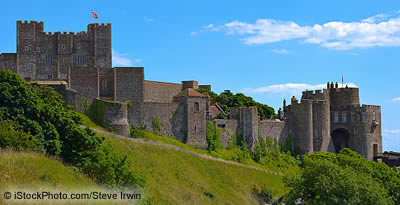Historical Dover
Official Dover Tourist Information Number: 01304 205 108
Dover provides the shortest sea route to France and has been a port for over 3000 years. You can see evidence of this by visiting the bronze age boat on display at the Dover museum. This amazing piece of history which is the world’s oldest known seagoing vessel was discovered in Dover in 1992 during roadworks in the town.
Dover Museum charts the history of Dover from the bronze age through to the present day. Look out for the beautiful Saxon jewellery and the Roman pottery.
The Roman painted house in Dover is the remains of a Roman hotel and dates from around 200AD. It has some superb well preserved wall paintings.
 The Roman pharos (lighthouse), on the Eastern heights in the grounds of Dover castle, is believed to be one of a pair built by the Romans to guide their ships across the Channel to Dover.
The Roman pharos (lighthouse), on the Eastern heights in the grounds of Dover castle, is believed to be one of a pair built by the Romans to guide their ships across the Channel to Dover.
Dover castle occupies the site of an iron age fort. Located over 450 feet above sea level it has a commanding view of the channel. It is basically a Norman castle with Napoleonic and world war II tunnels beneath it. The building of Dover castle spanned the reigns of several kings. It was started by William the Conqueror. A large portion was built by Henry II and work continued into the reign of Edward IV.
The Great Tower at Dover castle reopened in August 2009 after £2.45 million English Heritage project to restore it closer to its original 1180’s condition. The Great Tower would have been the venue for welcoming VIP pilgrims on their way to Thomas Becket’s shrine in Canterbury Cathedral.
The Maison Dieu building was built in 1203 and is one of the oldest buildings in Dover. It is now the town hall but over the years it has seen many changes. It has been a pilgrims hospital, a naval supplies office, a prison, a court and a chapel.
The old Buckland Paper Mill buildings at the bottom of Crabble Hill were built around 1770 with the clock tower being added around 1895. The mill closed in 1999 for redevelopment.
Crabble corn mill is a beautifully preserved Georgian water mill. It was built in 1812 and is now open to the public as a working museum.
On the Western heights in Dover you can find the biggest Napoleonic fortification in Britain. The most famous part of this fortification is the Grand Shaft. This unique triple staircase is 42m high and consists of 3 staircases that wind down one above the other. It was designed for the rapid movement of troops between the Western Heights and Dover town.
The South Foreland Lighthouse on Dover’s White Cliffs was built in 1843 and was used by Marconi to test his pioneering radio navigation equipment.
Dover earned the nickname ‘Hellfire Corner’ during WWII because of the intense shelling from big guns on the French coast. About 1000 buildings were destroyed and about 3000 were severely damaged. Despite this, Dover still has plenty for history buffs.
Many of the secret wartime tunnels beneath Dover castle are now open to visitors and give a real flavour of the work that went on beneath the castle during WWII.